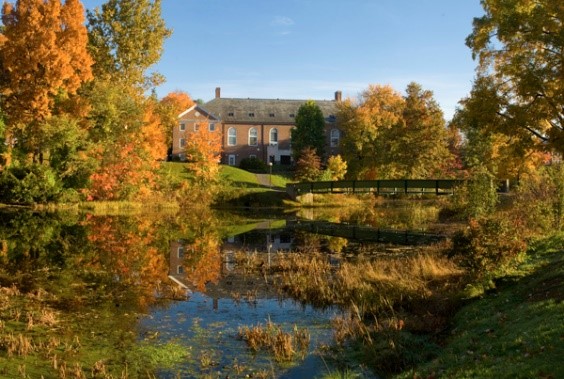Williston’s Strides in Sustainability

The view of the Williston Northampton School in the fall, facing the Reed Campus Center.
Williston has been making consistent efforts in controlling its environmental impact.
Numerous actions have been taken to promote positive environmental stewardship, according to the Williston homepage. Such actions impacted various campus locations such as dormitories, faculty residences, outdoors, and athletic facilities.
Sustainable actions have taken place at the Birch Dining Commons as well. A composting program, tray-less meals, and a dishwasher that consumes less water are the means and equipment used to reduce food, water, and energy waste, according to Christopher Couchon, Assistant Food Service Director at SAGE Dining Services.
“Our current composting program is pretty straightforward,” said Couchon. “They come once a week. We compost what we can for food waste. No trash or non-compostable materials are taken other than food.”
Couchon said “tray-less meals” began about 10 or 12 years ago, prior to SAGE being here. The policy was implemented by the school to cut down on food and water waste. “It was extremely successful,” he said.
In addition to these actions, SAGE is planning to implement a “Weigh the Waste” program in the future, according to Couchon.
Weigh the Waste is a fun and interactive way to engage students in understanding how much plate waste an individual can produce at the end of a meal, according to Food Recovery Network. The aim is to expose how much food students throw away to demonstrate that even unintentionally, everyone causes food waste.
The school has taken more action, including the use of geothermal energy among the three newest dorms, natural gas, insulated windows, LED lights, central energy management system, and solar panels on the ceiling of the athletic facility and EMV, according to Charles McCullagh, Chief Financial Officer at Williston.
“Wold House, EMV, and John Hazen White are geothermal,” McCullagh explained. “So, what that means is that instead of burning fossil fuel to heat the building, we use the constant temperature in the ground and we run the heating systems and the air-conditioning systems. It’s a constant 55 degrees. So all you have to do is boost it a little for the heat or use that for your source of cooling.”
“The beauty of this,” McCullagh added, “is that we don’t use fossil fuels [nearly] at all.”
Geothermal heating and cooling is not the only technology installed in the dorms. John Hazen White and Emily McFadon Vincent House have solar panels on top of them which are used to help heat the water, according to McCullagh.
Solar panels are also on the roofs of the Lossone Ice Hockey Rink and the Cain Athletic Center, where energy produced is used slightly differently than JHW and EMV.
McCullagh said, “Solar arrays generate electricity which goes into the [general] electrical grid. By putting in the utility records what we generated, they give us credit against the electricity we are paying for. We are generating solar electricity that we ultimately benefit from.”
Many solar arrays have been installed so far, and there have been attempts to expand the area of solar arrays across a piece of barren land in Easthampton bought for this purpose. There are challenges to solve before the plan can be implemented; McCullagh and his group are keeping their eyes out for a solution.
“Further down the street we bought a piece of property, a number of years ago and we wanted to put big [a] solar array [there] but arrangements with the companies [were needed]. We have gone through three times [about ways] to install [solar panels] on that property but it never made sense financially or otherwise. If I can find the solar company that can do it effectively for the school, I will do it immediately,” McCullagh said.
Sustainability in Williston has been improving over the years, yet there are more possibilities for growth. Various action for that purpose are being taken, McCullagh said. To maintain a lead in sustainability efforts, communication is crucial between with the Board of Trustees, other institutions, peer boarding schools, and surrounding colleges.
As an example, “The heating and air-conditioning system Williston will install this coming summer in the Chapel is the direct result of our conversation with one of our board members, who happens to be involved in the heating and air conditioning business.” McCullagh said. “She saw some of these newer systems being put in place so she was able to show us, through her company, some of these systems that are being installed right now and investigate that technology.”
McCullagh said he and his staff are “constantly talking with the other [surrounding] institutions and peer schools and colleges and universities, who would have done some research themselves. We are always constantly sharing [information regarding sustainable technology].”
The Biden administration has set a target of powering five million American homes with community solar projects by 2025 – a project “that would require 700% growth of current capacity,” according to Renewable Energy World.










